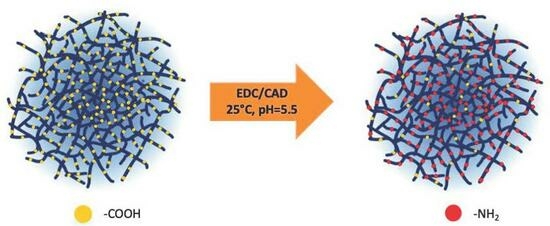Preparation of Amino-Functionalized Poly(N-isopropylacrylamide)-Based Microgel Particles
Abstract
:1. Introduction
2. Results and Discussion
2.1. Synthesis and Characterization of P(NIPAm-co-10%AAc) Microgels
2.2. Post-Polymerization Modification of the P(NIPAm-co-10%AAc) Microgels to Primary Amine Functionalized Microgels by EDC Coupling
3. Conclusions
4. Materials and Methods
4.1. Materials
4.2. Synthesis of Microgel Particles
4.3. Functionalization of the Microgel Particles by a Diamine Using EDC-Coupling
4.4. High Performance Liquid Chromatography (HPLC) Measurements
4.5. Dynamic Light Scattering (DLS) Measurements
4.6. Electrophoretic Mobility Measurements
Author Contributions
Funding
Institutional Review Board Statement
Informed Consent Statement
Data Availability Statement
Conflicts of Interest
References
- Pelton, R. Temperature-sensitive aqueous microgels. Adv. Colloid Interface Sci. 2000, 85, 1–33. [Google Scholar] [CrossRef]
- Dupin, D.; Fujii, S.; Armes, S. Efficient Synthesis of Sterically Stabilized pH-Responsive Microgels of Controllable Particle Diameter by Emulsion Polymerization. Langmuir 2006, 22, 3381–3387. [Google Scholar] [CrossRef] [PubMed]
- Zrínyi, M. Intelligent polymer gels controlled by magnetic fields. Colloid Polym. Sci. 2000, 278, 98–103. [Google Scholar] [CrossRef]
- Snowden, J.M.; Chowdhry, B.Z.; Vincent, B.; Morris, G.E. Colloidal copolymer microgels of N-isopropylacrylamide and acrylic acid: PH, ionic strength and temperature effects. J. Chem. Soc. Faraday Trans. 1996, 92, 5013–5016. [Google Scholar] [CrossRef]
- Nayak, S.; Lyon, A. Photoinduced Phase Transitions in Poly(N-isopropylacrylamide) Microgels. Chem. Mater. 2004, 16, 2623–2627. [Google Scholar] [CrossRef]
- Le Goff, G.C.; Srinivas, R.L.; Hill, W.A.; Doyle, P.S. Hydrogel microparticles for biosensing. Eur. Polym. J. 2015, 72, 386–412. [Google Scholar] [CrossRef]
- Oh, J.K.; Drumright, R.; Siegwart, D.J.; Matyjaszewski, K. The development of microgels/nanogels for drug delivery applications. Prog. Polym. Sci. 2008, 33, 448–477. [Google Scholar] [CrossRef]
- Zhang, J.; Xu, S.; Kumacheva, E. Polymer Microgels: Reactors for Semiconductor, Metal, and Magnetic Nanoparticles. J. Am. Chem. Soc. 2004, 126, 7908–7912. [Google Scholar] [CrossRef]
- Sahiner, N. Soft and flexible hydrogel templates of different sizes and various functionalities for metal nanoparticle preparation and their use in catalysis. Prog. Polym. Sci. 2013, 38, 1329–1356. [Google Scholar] [CrossRef]
- Shibayama, M.; Tanaka, T. Volume Phase Transition and Related Phenomena of Polymer Gels. Adv. Polym. Sci. 1993, 109, 1–62. [Google Scholar] [CrossRef]
- Pelton, R. Poly(N-isopropylacrylamide) (PNIPAM) is never hydrophobic. J. Colloid Interface Sci. 2010, 348, 673–674. [Google Scholar] [CrossRef]
- Musial, W.; Pluta, J.; Michalek, J. Thermosensitive Microgels of Poly-N-isopropylacrylamide for Drug Carriers—Practical Approach to Synthesis. Acta Pol. Pharm. Drug Res. 2015, 72, 409–422. [Google Scholar]
- Bao, L.; Zha, L. Preparation of Poly(N-isopropylacrylamide) Microgels using Different Initiators Under Various pH Values. J. Macromol. Sci. Part A Pure Appl. Chem. 2006, 43, 1765–1771. [Google Scholar] [CrossRef]
- Pich, A.; Richtering, W. Microgels by Precipitation Polymerization: Synthesis, Characterization, and Functionalization. Adv. Polym. Sci. 2010, 234, 1–37. [Google Scholar] [CrossRef]
- Virtanen, O.L.J.; Richtering, W. Kinetics and particle size control in non-stirred precipitation polymerization of N-isopropylacrylamide. Colloid Polym. Sci. 2014, 292, 1743–1756. [Google Scholar] [CrossRef]
- Virtanen, O.L.J.; Ala-Mutka, H.M.; Richtering, W. Can the Reaction Mechanism of Radical Solution Polymerization Explain the Microgel Final Particle Volume in Precipitation Polymerization of N-Isopropylacrylamide? Macromulecular Chem. Phys. 2015, 216, 1431–1440. [Google Scholar] [CrossRef]
- Virtanen, O.L.J.; Brugnoni, M.; Kather, M.; Pich, A.; Richtering, W. The next step in precipitation polymerization of N-isopropylacrylamide: Particle number density control by monochain globule surface charge modulation. Polym. Chem. 2016, 7, 5123–5131. [Google Scholar] [CrossRef]
- Kardos, A.; Gilányi, T.; Varga, I. How small can poly(N-isopropylacrylamide) nanogels be prepared by controlling the size with surfactant? J. Colloid Interface Sci. 2019, 557, 793–810. [Google Scholar] [CrossRef]
- McPhee, W.; Tam, K.C.; Pelton, R. Poly(N-Isopropylacrylamide) Latices Prepared with Sodium Dodecyl-sulfate. J. Colloid Interface Sci. 1993, 156, 24–30. [Google Scholar] [CrossRef]
- Wu, X.; Pelton, R.H.; Hamielec, A.E.; Woods, D.R.; McPhee, W. The kinetics of poly(N-isopropylacrylamide) microgel latex formation. Colloid Polym. Sci. 1994, 272, 467–477. [Google Scholar] [CrossRef]
- Varga, I.; Gilányi, T.; Mészáros, R.; Filipcsei, G.; Zrínyi, M. Effect of Cross-Link Density on the Internal Structure of Poly(N-isopropylacrylamide) Microgels. J. Phys. Chem. B 2001, 105, 9071–9076. [Google Scholar] [CrossRef]
- Crowther, H.M.; Saunder, B.R.; Mears, S.J.; Cosgrove, T.; Vincent, B.; King, S.M.; Yu, G.E. Poly(NIPAM) microgel particle de-swelling: A light scattering and small-angle neutron scattering study. Colloids Surf. A Physicochem. Eng. Asp. 1999, 152, 327–333. [Google Scholar] [CrossRef]
- Saunders, B.R. On the Structure of Poly(N-isopropylacrylamide) Microgel Particles. Langmuir 2004, 20, 3925–3932. [Google Scholar] [CrossRef]
- Acciaro, R.; Gilányi, T.; Varga, I. Preparation of Monodisperse Poly(N-isopropylacrylamide) Microgel Particles with Homogenous Cross-Link Density Distribution. Langmuir 2011, 27, 7917–7925. [Google Scholar] [CrossRef]
- Hertle, Y.; Hellweg, T. Thermoresponsive copolymer microgels. J. Mater. Chem. B 2013, 1, 5874–5885. [Google Scholar] [CrossRef]
- Begum, R.; Farooqi, Z.H.; Khan, S.R. Poly(N-isopropylacrylamide-Acrylic acid) Copolymer Microgels for Various Applications: A Review. Int. J. Polym. Mater. Polym. Biomater. 2016, 65, 841–852. [Google Scholar] [CrossRef]
- Brazel, C.S.; Peppas, N.A. Synthesis and Characterization of Thermo- and Chemomechanically Responsive Poly(N-isopropylacrylamide-co-methacrylic acid) Hydrogels. Macromolecules 1995, 28, 8016–8020. [Google Scholar] [CrossRef]
- Nolan, C.M.; Reyes, C.D.; Debord, J.D.; García, A.J.; Lyon, L.A. Phase Transition Behavior, Protein Adsorption, and Cell Adhesion Resistance of Poly(ethylene glycol) Cross-Linked Microgel Particles. Biomacromolecules 2005, 6, 2032–2039. [Google Scholar] [CrossRef] [PubMed]
- Sayed, J.E.; Lorthioir, C.; Perrin, P.; Sanson, N. PEGylated NiPAM microgels: Synthesis, characterization and colloidal stability. Soft Matter 2019, 15, 963–972. [Google Scholar] [CrossRef]
- Xiong, W.; Gao, X.; Zhao, Y.; Xu, H.; Yang, X. The dual temperature/pH-sensitive multiphase behavior of poly (N-isopropylacrylamide-co-acrylic acid) microgels for potential application in in situ gelling system. Colloids Surf. B Biointerfaces 2011, 84, 103–110. [Google Scholar] [CrossRef]
- Meunier, F.; Elaissari, A.; Pichot, C. Preparation and Characterization of Cationic Poly(n-Isopropylacrylamide) Copolymer Latexes. Polym. Adv. Technol. 1995, 6, 489–496. [Google Scholar] [CrossRef]
- Zha, L.; Hu, J.; Wang, C.; Fu, S.; Elaissari, A.; Zhang, Y. Preparation and characterization of poly(n-isopropylacrylamide-co-dimethylaminoethyl methacrylate) microgel latexes. Colloid Polym. Sci. 2002, 280, 1–6. [Google Scholar] [CrossRef]
- Zhang, Y.; Zha, L.S.; Fu, S.K. Kinetic Analysis of Poly(N-isopropylacrylamide-co-dimethylaminoethyl methacrylate) Microgel Latex Formation. J. Appl. Polym. Sci. 2004, 92, 839–846. [Google Scholar] [CrossRef]
- Hu, X.; Tong, Z.; Lyon, L.A. Synthesis and physicochemical properties of cationic microgels based on poly(N-isopropylmethacrylamide). Colloid Polym. Sci. 2011, 289, 333–339. [Google Scholar] [CrossRef] [PubMed]
- Annegarn, M.; Dirksen, M.; Hellweg, T. Importance of pH in Synthesis of pH-Responsive Cationic Nano- and Microgels. Polymers 2021, 13, 827. [Google Scholar] [CrossRef] [PubMed]
- Meng, Z.; Hendrickson, G.R.; Lyon, L.A. Simultaneous Orthogonal Chemoligations on Multiresponsive Microgels. Macromolecules 2009, 42, 7664–7669. [Google Scholar] [CrossRef]
- Wei, Y.Y.; Liu, Z.; Luo, F.; Zhang, L.; Wang, W.; Ju, X.J.; Xie, R.; Chu, L.Y. A Novel Poly(N-Isopropylacrylamide-co-acryloylamidobenzo-12-crown-4) Microgel with Rapid Stimuli-Responsiveness for Molecule-Specific Adsorption of γ-Cyclodextrin. Macromol. Chem. Phys. 2017, 218, 1700216. [Google Scholar] [CrossRef]
- Shiroya, T.; Tamura, N.; Yasui, M.; Fujimoto, K. Enzyme immobilization on thermosensitive hydrogel microspheres. Colloids Surf. B Biointerfaces 1995, 4, 267–274. [Google Scholar] [CrossRef]
- Horecha, M.; Senkovsky, V.; Synytska, A.; Stamm, M.; Chervanyov, I.; Kiriy, A. Ordered surface structures from PNIPAM-based loosely packed microgel particles. Soft Matter 2010, 6, 5980–5992. [Google Scholar] [CrossRef]
- Singh, N.; Lyon, L.A. Synthesis of multifunctional nanogels using a protected macromonomer approach. Colloid Polym. Sci. 2008, 286, 1061–1069. [Google Scholar] [CrossRef]
- Wang, C.; Yan, Q.; Liu, H.B.; Zhou, X.H.; Xiao, S.J. Different EDC/NHS Activation Mechanisms between PAA and PMAA Brushes and the Following Amidation Reactions. Langmuir 2011, 27, 12058–12068. [Google Scholar] [CrossRef]
- Totaro, K.; Liao, X.; Bhattacharya, K.; Finneman, J.I.; Sperry, J.B.; Massa, M.A.; Thorn, J.; Pentelute, B.L. Systematic Investigation of EDC/sNHS-Mediated Bioconjugation Reactions for Carboxylated Peptide Substrates. Bioconjugate Chem. 2016, 27, 994–1004. [Google Scholar] [CrossRef] [PubMed]
- Su, S.; Wang, H.; Liu, X.; Wu, Y.; Nie, G. iRGD-coupled responsive fluorescent nanogel for targeted drug delivery. Biomaterials 2013, 34, 3523–3533. [Google Scholar] [CrossRef] [PubMed]
- Das, M.; Mardyani, S.; Chan, W.C.W.; Kumacheva, E. Biofunctionalized pH-Responsive Microgels for Cancer Cell Targeting: Rational Design. Adv. Mater. 2006, 18, 80–83. [Google Scholar] [CrossRef]
- Lai, E.; Wang, Y.; Wei, Y.; Li, G.; Ma, G. Covalent immobilization of trypsin onto thermo-sensitive poly(N-isopropylacrylamide-co-acrylic acid) microspheres with high activity and stability. J. Appl. Polym. Sci. 2016, 133, 43343. [Google Scholar] [CrossRef]
- Kratz, K.; Elmer, W. Swelling Properties of Colloidal Poly(N-Isopropylacrylamide) Microgels in Solution. Berichte Der Bunsen-Ges.-Phys. Chem. Chem. Phys. 1998, 102, 848–854. [Google Scholar] [CrossRef]
- Kratz, K.; Hellweg, T.; Eimer, W. Influence of charge density on the swelling of colloidal poly(N-isopropylacrylamide-co-acrylic acid) microgels. Colloids Surf. A Physicochem. Eng. Asp. 2000, 170, 137–149. [Google Scholar] [CrossRef]
- Hoare, T.; Pelton, R. Highly pH and Temperature Responsive Microgels Functionalized with Vinylacetic Acid. Macromolecules 2004, 37, 2544–2550. [Google Scholar] [CrossRef]
- Gilles, M.A.; Hudson, A.Q.; Bordere, C.L. Stability of Water-Soluble Carbodiimides in Aqueous Solution. Analyticalbiochemistry 1990, 184, 244–248. [Google Scholar] [CrossRef]
- Lei, Q.P.; Lamb, D.H.; Heller, R.K.; Shannon, A.G.; Ryall, R.; Cash, P. Kinetic studies on the rate of hydrolysis of N-ethyl-N′-(dimethylaminopropyl)carbodiimide in aqueous solutions using mass spectrometry and capillary electrophoresis. Anal. Biochem. 2002, 310, 122–124. [Google Scholar] [CrossRef]
- Hermanson, G.T. Bioconjugate Techniques, 3rd ed.; Academic Press: Cambridge, MA, USA, 2013; pp. 259–373. ISBN 978-0-12-382239-0. [Google Scholar]
- Kennedy, G.L. Review of the Toxicology of Three Alkyl Diamines. Drug Chem. Toxicol. 2007, 30, 145–157. [Google Scholar] [CrossRef]
- del Rio, B.; Redruello, B.; Linares, D.M.; Ladero, V.; Ruas-Madiedo, P.; Fernandez, M.; Martin, M.C.; Alvarez, M.A. The biogenic amines putrescine and cadaverine show in vitro cytotoxicity at concentrations that can be found in foods. Sci. Rep. 2019, 9, 120. [Google Scholar] [CrossRef]
- Thünemann, A.F.; Müller, M.; Dautzenberg, H.; Joanny, J.F.; Löwen, H. Polyelectrolyte Complexes. Adv. Polym. Sci. 2004, 166, 113–171. [Google Scholar] [CrossRef]
- Mezei, A.; Mészáros, R. Novel Method for the Estimation of the Binding Isotherms of Ionic Surfactants on Oppositely Charged Polyelectrolytes. Langmuir 2006, 22, 7148–7151. [Google Scholar] [CrossRef] [PubMed]
- Jones, C.D.; Lyon, L.A. Synthesis and Characterization of Multiresponsive Core-Shell Microgels. Macromolecules 2000, 33, 8301–8306. [Google Scholar] [CrossRef]
- Webber, M.J.; Pashuck, E.T. (Macro)molecular self-assembly for hydrogel drug delivery. Adv. Drug Deliv. Rev. 2021, 172, 275–295. [Google Scholar] [CrossRef] [PubMed]
- Jung, H.; Kim, M.K.; Lee, J.Y.; Choi, S.W.; Kim, J. Adhesive Hydrogel Patch with Enhanced Strength and Adhesiveness to Skin for Transdermal Drug Delivery. Adv. Funct. Mater. 2020, 42, 2004407. [Google Scholar] [CrossRef]
- Ge, G.; Wang, Q.; Zhang, Y.Z.; Alshareef, H.N.; Dong, X. 3D Printing of Hydrogels for Stretchable Ionotronic Devices. Adv. Funct. Mater. 2022, 52, 2107437. [Google Scholar] [CrossRef]
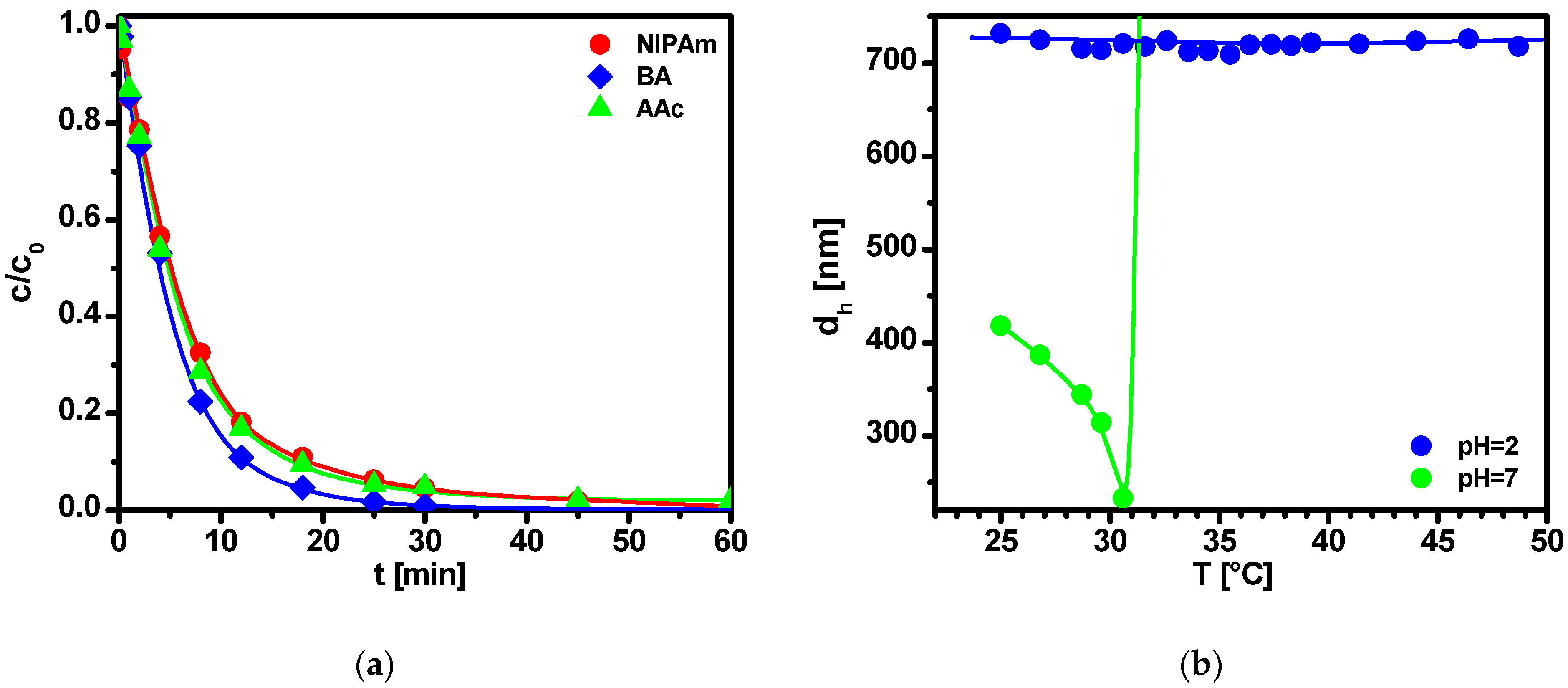
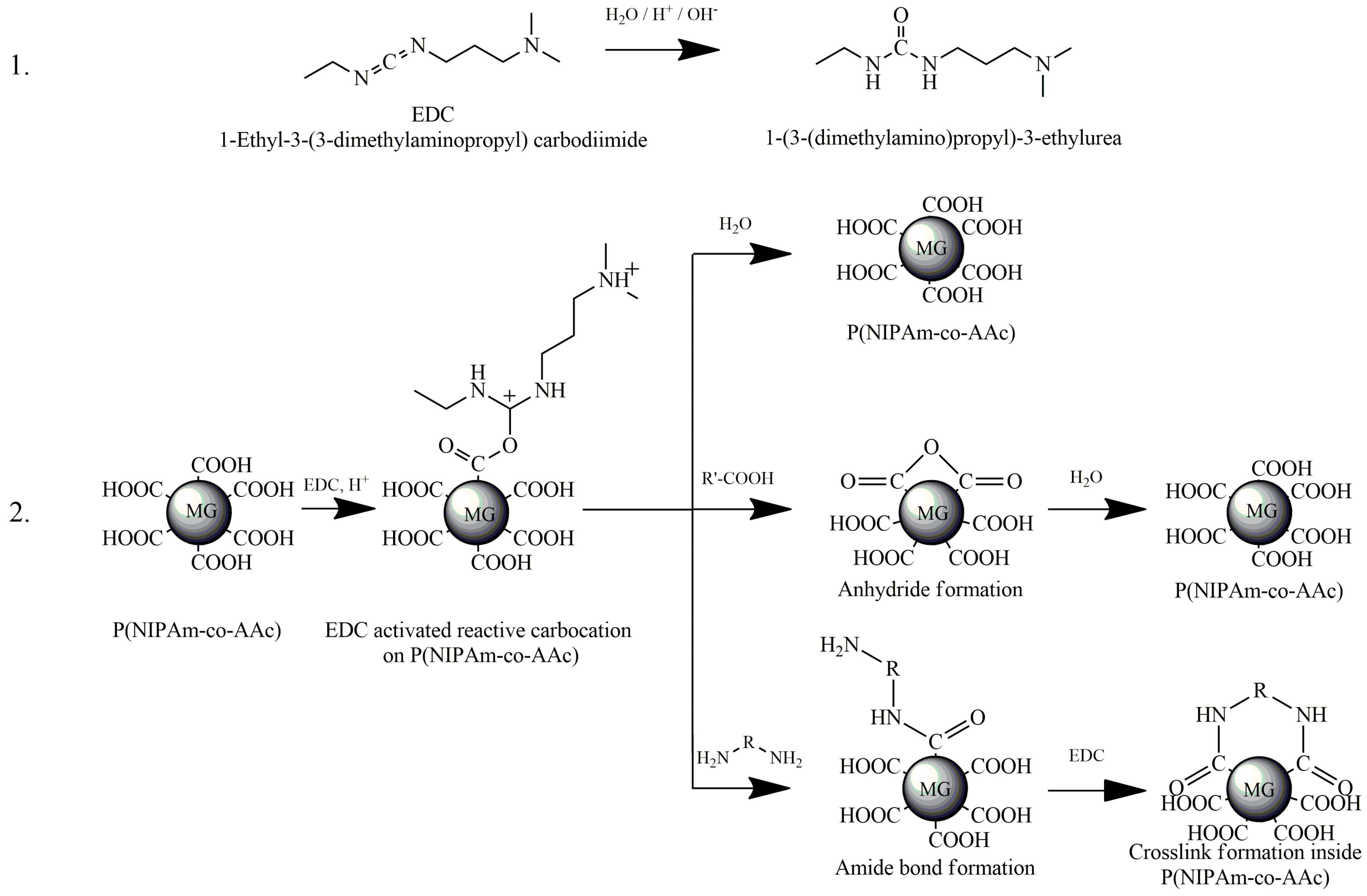
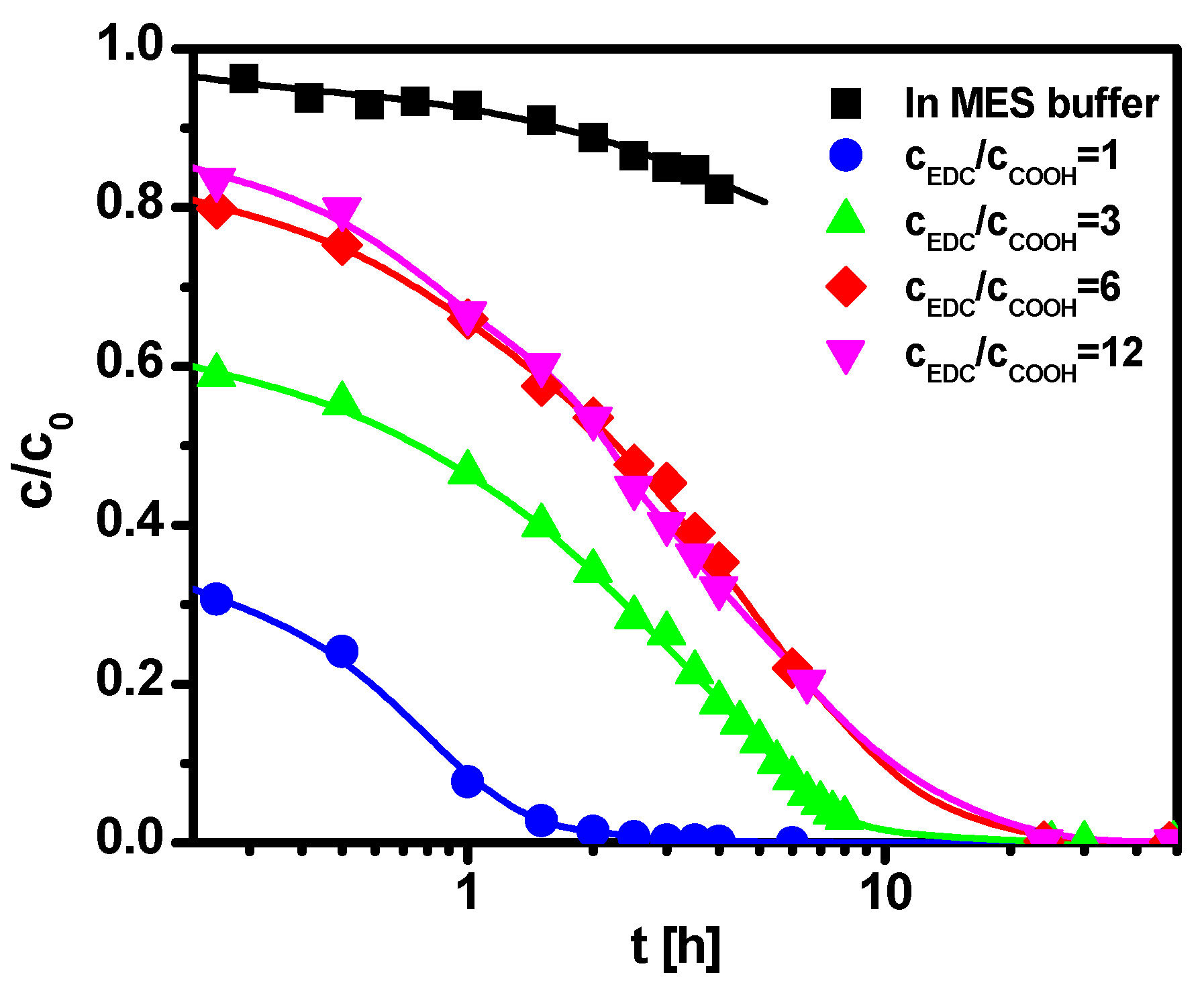
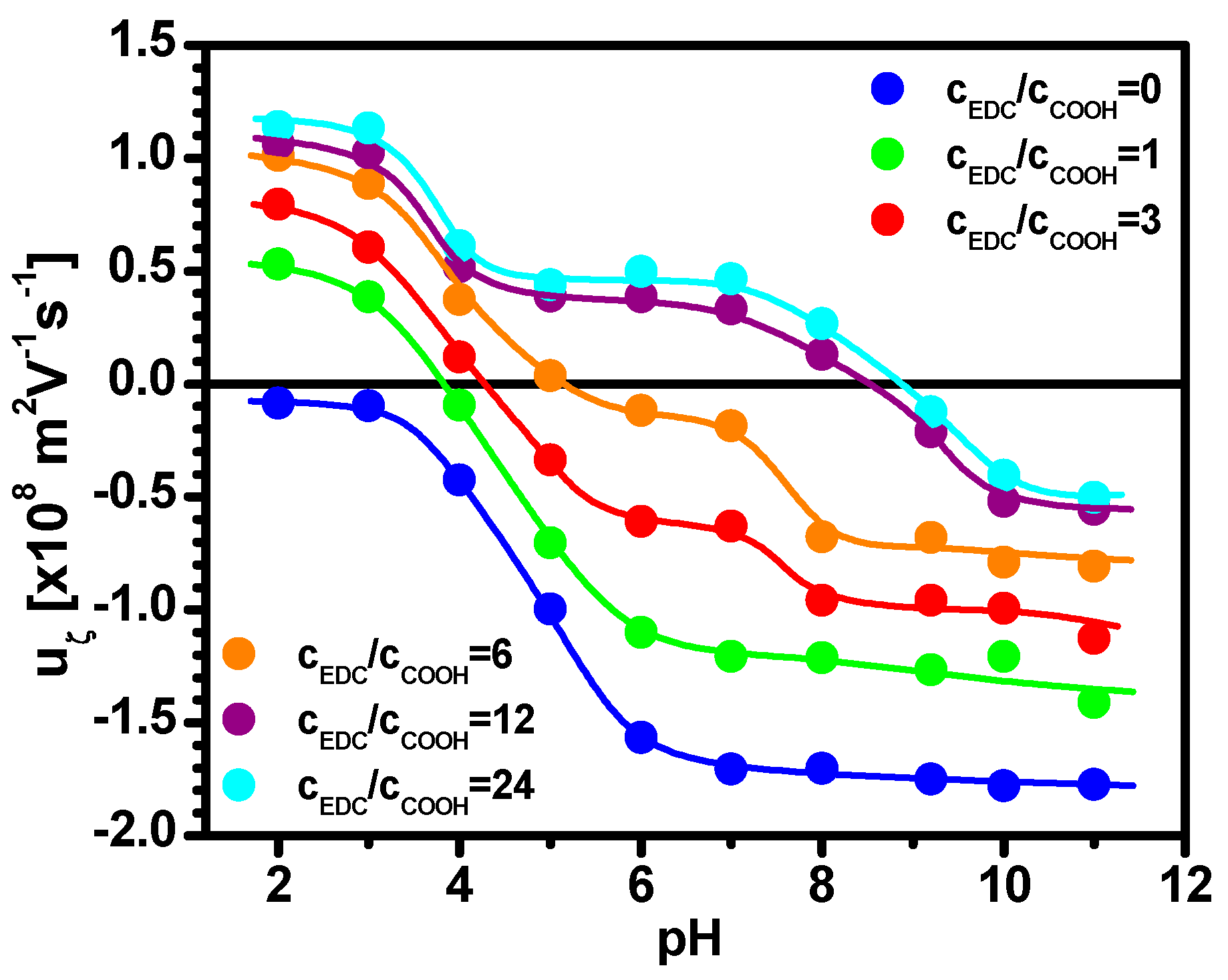

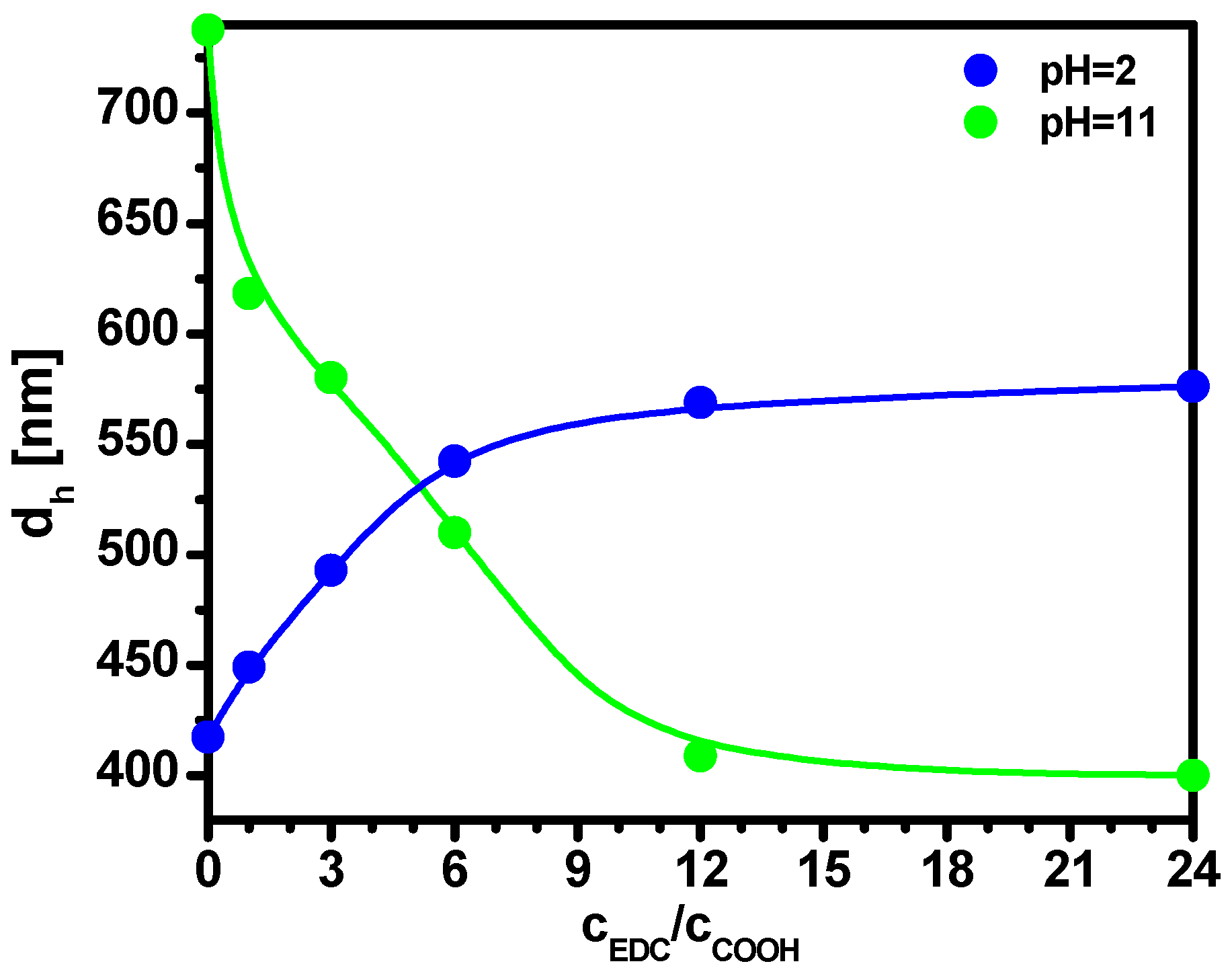

| P(NIPAm-co-10%AAc) | NH2-Functionalized MG | |
|---|---|---|
| - | 6.33 mmol NH2/g MG | |
| 9.61 mmol COOH/g MG | 3.65 mmol COOH/g MG |
Disclaimer/Publisher’s Note: The statements, opinions and data contained in all publications are solely those of the individual author(s) and contributor(s) and not of MDPI and/or the editor(s). MDPI and/or the editor(s) disclaim responsibility for any injury to people or property resulting from any ideas, methods, instructions or products referred to in the content. |
© 2023 by the authors. Licensee MDPI, Basel, Switzerland. This article is an open access article distributed under the terms and conditions of the Creative Commons Attribution (CC BY) license (https://creativecommons.org/licenses/by/4.0/).
Share and Cite
Harsányi, A.; Kardos, A.; Varga, I. Preparation of Amino-Functionalized Poly(N-isopropylacrylamide)-Based Microgel Particles. Gels 2023, 9, 692. https://doi.org/10.3390/gels9090692
Harsányi A, Kardos A, Varga I. Preparation of Amino-Functionalized Poly(N-isopropylacrylamide)-Based Microgel Particles. Gels. 2023; 9(9):692. https://doi.org/10.3390/gels9090692
Chicago/Turabian StyleHarsányi, Anna, Attila Kardos, and Imre Varga. 2023. "Preparation of Amino-Functionalized Poly(N-isopropylacrylamide)-Based Microgel Particles" Gels 9, no. 9: 692. https://doi.org/10.3390/gels9090692
APA StyleHarsányi, A., Kardos, A., & Varga, I. (2023). Preparation of Amino-Functionalized Poly(N-isopropylacrylamide)-Based Microgel Particles. Gels, 9(9), 692. https://doi.org/10.3390/gels9090692





